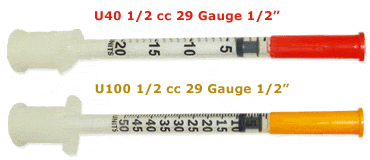I get many questions from owners of pets with diabetes. This month, I address pet insulin syringes.
Dear Dr. Gary,
My dog has been getting 5 units of insulin with U-40 syringes, but I ran out of syringes and I all have are U-100 syringes. Is 1 unit of insulin in a U-40 syringe equal to 1 unit in a U-100 syringe?
George
For George and other pet owners, I’m sure it gets confusing at times. Let’s back up a moment so I can explain the difference between U-40 and U-100.
Always discuss your pet’s health with your veterinarian before administering any medication.
A vial of insulin contains a sterile solution and an insulin source. The amount of insulin your dog or cat needs is measured in units. Veterinary insulin is available in different concentrations, commonly known as U-40 or U-100 vials. The “U” is an abbreviation of unit and the number after the unit represents the concentration, i.e. how many units (‘pieces of insulin’) are in one milliliter (mL).
A U-40 syringe has 40 units (‘pieces of insulin’) per mL and a U-100 syringes has 100 units (‘pieces of insulin’) per mL. This means there is approximately 2.5 times more insulin (‘pieces’) in a unit of U-100 insulin compared to U-40 insulin or to put it another way the same amount of U-100 insulin is 2.5 times stronger than the U-40.
U-40 and U-100 are the common insulin concentrations and syringe types used to treat dogs and cats. To give insulin to your animal, there are two types of syringes available, U-40 and U-100. A 1 mL syringe is universal, but the difference is a U-40 syringe has unit increments up to 40, whereas a U-100 syringe has markings up to 100.
Looking at a ½ mL of insulin in each syringe, a U-40 will have 20 units and a U-100 will contain 50 units of insulin. It is essential for your diabetic pet that the proper insulin and syringe is used to deliver the correct amount of insulin.

Some pet owners may have access to U-40 or U-100 syringes that may not match the bottle of insulin they are using. It is possible to mix insulin and syringe, but using syringes and insulin that were not prescribed is not recommended without consulting your veterinarian.
If any changes are made, it is important that you communicate with your veterinarian prior. Your veterinarian will need to know of any changes to the type of insulin, the type of insulin syringe and the amount of units given so the correct dose is determined prior to any change.






Leave A Comment